Optimal Operation Strategy for Wind–Photovoltaic Power-Based Hydrogen Production Systems Considering Electrolyzer Start-Up Characteristics
Abstract
:1. Introduction
2. Structure of Wind–Solar Hydrogen Production System
3. A Multi-State Operation Model for Electrolytic Cells Considering Cold and Hot Start Times
- (1)
- Multi-state transition model for electrolytic cells
- (2)
- A current power linearization model for electrolytic cells in multiple states
- (3)
- Model of working range of electrolytic cell
- (4)
- Energy Conversion Model for Electrolytic Cell Electricity Hydrogen
4. Optimization Operation Model of 3 Wind–Solar Hydrogen Production Systems
4.1. Objective Function
4.2. Constraints
- (1)
- Power balance constraints of wind–solar hydrogen production system
- (2)
- Grid connected operation constraints
- (3)
- Operational constraints of hydrogen storage tanks
- (4)
- Constraints related to the operation of electrochemical energy storage
5. Case Study
5.1. Parameter Settings
5.2. Comparative Analysis of Plans
- (1)
- Economic analysis
- (2)
- System operation status analysis
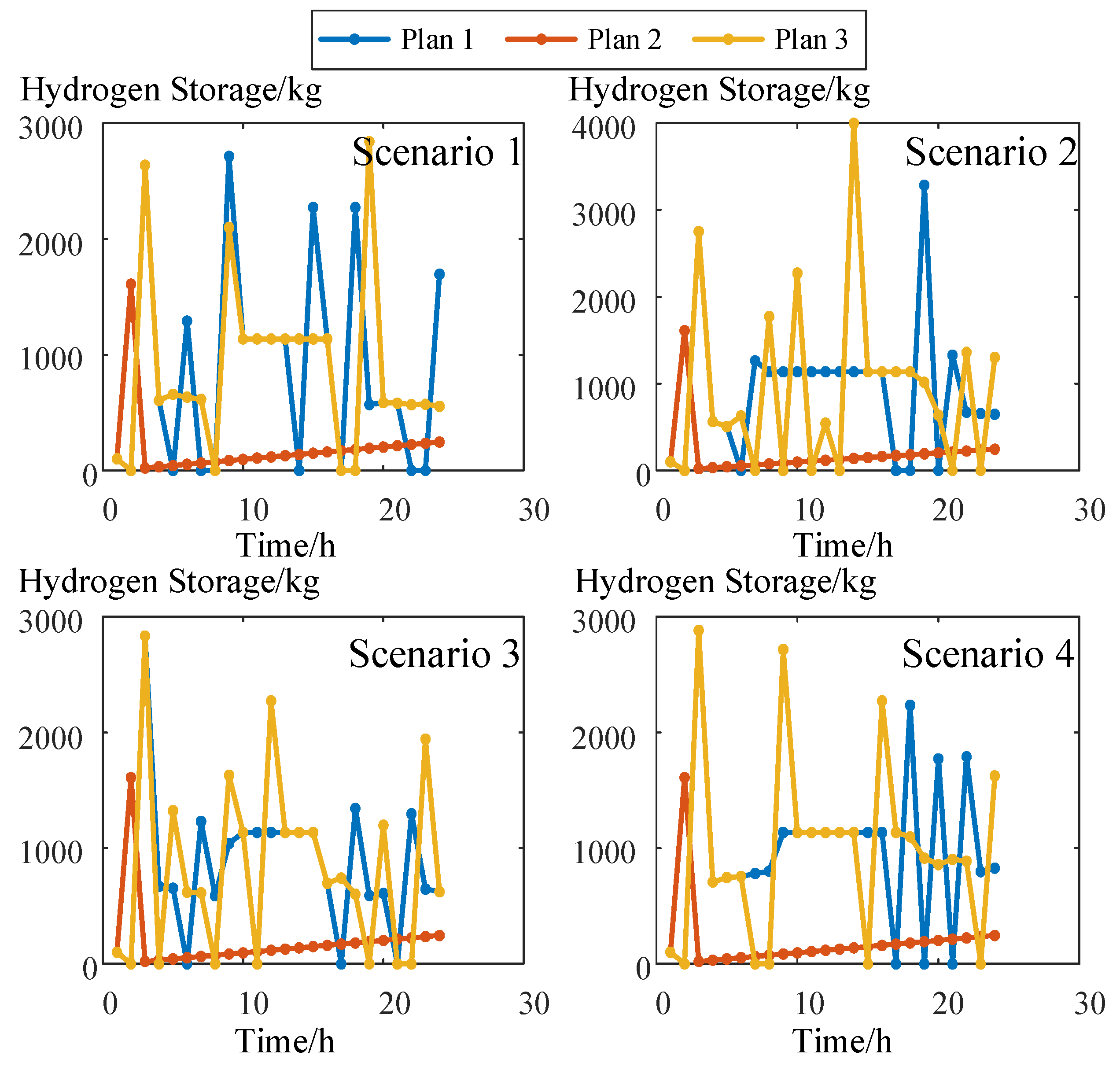
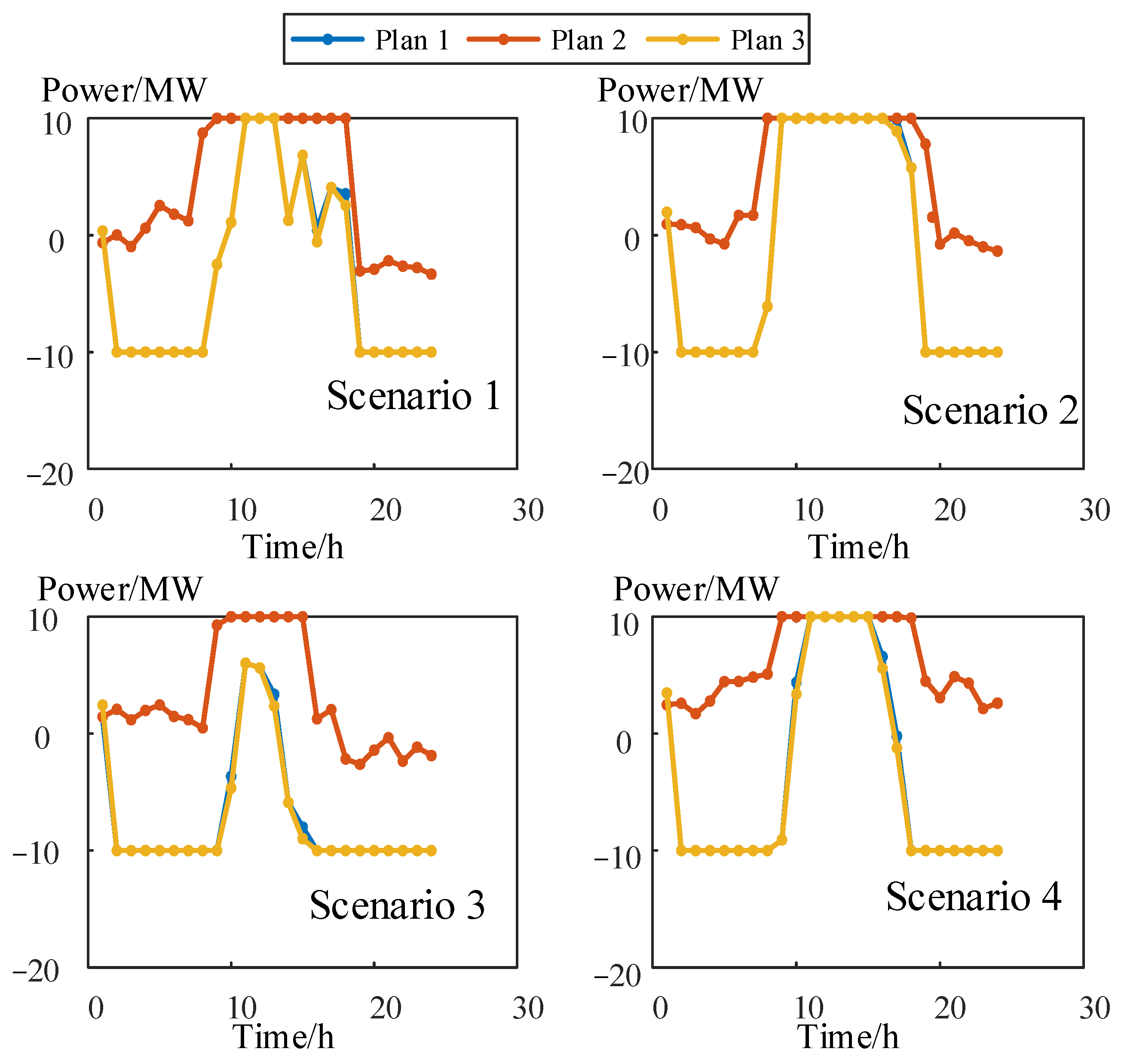
5.3. Analysis of the Impact of Hydrogen Storage Tank Capacity on System Operating Revenue

6. Conclusions
Author Contributions
Funding
Data Availability Statement
Conflicts of Interest
Appendix A
References
- Yang, L.; Li, H.; Zhang, H.; Wu, Q.; Cao, X. Stochastic-Distributionally Robust Frequency-Constrained Optimal Planning for an Isolated Microgrid. IEEE Trans. Sustain. Energy 2024. early access. [Google Scholar] [CrossRef]
- National Energy Administration. National Renewable Energy Power Development Monitoring and Evaluation Report; National Energy Administration: Beijing, China, 2021.
- Chen, S. Research and Analysis of the Impact in the Wind-Solar-Battery Hybrid Generation System; China Electric Power Press: Beijing, China, 2016. [Google Scholar]
- Yang, L.; Xu, Y.; Zhou, J.; Sun, H. Distributionally Robust Frequency Constrained Scheduling for an Integrated Electricity-Gas System. IEEE Trans. Smart Grid 2022, 13, 2730–2743. [Google Scholar] [CrossRef]
- Li, J.; Yu, G.; Tang, B.; Yang, X.; Xia, X.; Liu, J.; Pan, A. Multi-energy Flow Integrated Energy System Planning Considering Wind and Solar Utilization and Containing Hydrogen Energy Flow. Power Syst. Prot. Control 2021, 49, 11–20. [Google Scholar]
- Cao, F.; Guo, T.; Chen, K.; Jin, X.L.; Zhang, L.; Yang, J.H.; Yin, A.M. Progress and Development Prospect of Coupled Wind and Hydrogen Systems. Proc. CSEE 2021, 41, 2187–2201. [Google Scholar]
- Li, T.; Sun, Y.-L.; Du, X.-R. Analysis of wind-solar hybrid power supply system. J. Qinghai Norm. Univ. 2011, 24–27. Available online: https://caod.oriprobe.com/articles/28144168/Analysis_of_wind_solar_hybrid_power_supply_system.htm (accessed on 12 August 2024).
- Cai, W.; Kong, L.; Bian, Y.; Song, J.; Xu, H. The Homogenization Modeling of Wind- photovoltaic System with Hydrogen Production. Electr. Power 2020, 53, 59–65. [Google Scholar]
- Li, Z.; Qiao, Y.; Lu, Z. Review of Rresearch on Wind-Hydrogen Coupled Power Generation Technology. Autom. Electr. Power Syst. 2022, 46, 104–112. [Google Scholar]
- Guo, M.; Yan, Z.; Zhou, Y.; Zhang, P. Optimization operation of comprehensive energy system including wind power hydrogen production equipment. China Electr. Power 2020, 53, 115–123+161. [Google Scholar]
- Wu, F. Optimization of Wind and Solar Hydrogen Storage Integrated Energy System. Shandong Chem. Ind. 2020, 49, 135–136+138. [Google Scholar]
- Yang, J.G.; Liu, W.M.; Li, S.X.; Deng, T.H.; Shi, Z.P.; Hu, Z.C. Optimal Operation Strategy and Benefit Analysis of Wind-Hydrogen Coupled Power Generation System. Electr. Power Constr. 2017, 38, 106–115. [Google Scholar]
- Wei, Z. Research of Capacity Optimization of Wind-Hydrogen Coupling System; Hebei University of Technology: Tianjin, China, 2020. [Google Scholar]
- Kong, L. Research on Optimal Sizing and Coordinated Control Stragy of Integrated Energy System of Wind Photovoltaitic and Hydrogen; North China Electric Power University: Beijing, China, 2017. [Google Scholar]
- Di, J.; Shen, Y.; Jia, M. Modeling and analysis of wind-hydrogen coupled power generation system. Therm. Power Gener. 2022, 51, 65–73. [Google Scholar]
- Qiu, Y.; Zhu, J.; Zeng, Y.; Zhou, Y.; Zhou, B.; Li, W. Technological Requirement Analysis and Prospect of Energy Management for Off-grid Renewable Power-to-Hydrogen Systems. Autom. Electr. Power Syst. 2024, 1–18. Available online: http://kns.cnki.net/kcms/detail/32.1180.TP.20240708.1014.003.html (accessed on 12 August 2024).
- Yuyang, Z.; Yuhuan, Z.; Yingjun, G. Capacity Configuration and Control Optimization of Off-Grid Wind Solar Hydrogen Storage System. Acta Energiae Solaris Sin. 2024, 45, 50–59. [Google Scholar]
- Sun, C. Research on Generation Expansion Planning Considering Hydrogen Load; Dalian University of Technology: Dalian, China, 2021. [Google Scholar]
- Zheng, Y.; Wang, J.; You, S.; Li, X.; Bindner, H.W.; Münster, M. Data-driven scheme for optimal day-ahead operation of a wind/hydrogen system under multiple uncertainties. Appl. Energy 2023, 329, 120201. [Google Scholar] [CrossRef]
- Raju, M.; Khaitan, S.K. System simulation of compressed hydrogen storage based residential wind hybrid power systems. J. Power Sources 2012, 210, 303–320. [Google Scholar] [CrossRef]
- Chen, C. Research on Modeling and Grid-Connected Control of Integerated System of Wind Power/Hydrogen/Fuel Cell; Northeast Electric Power University: Jilin City, China, 2017. [Google Scholar]
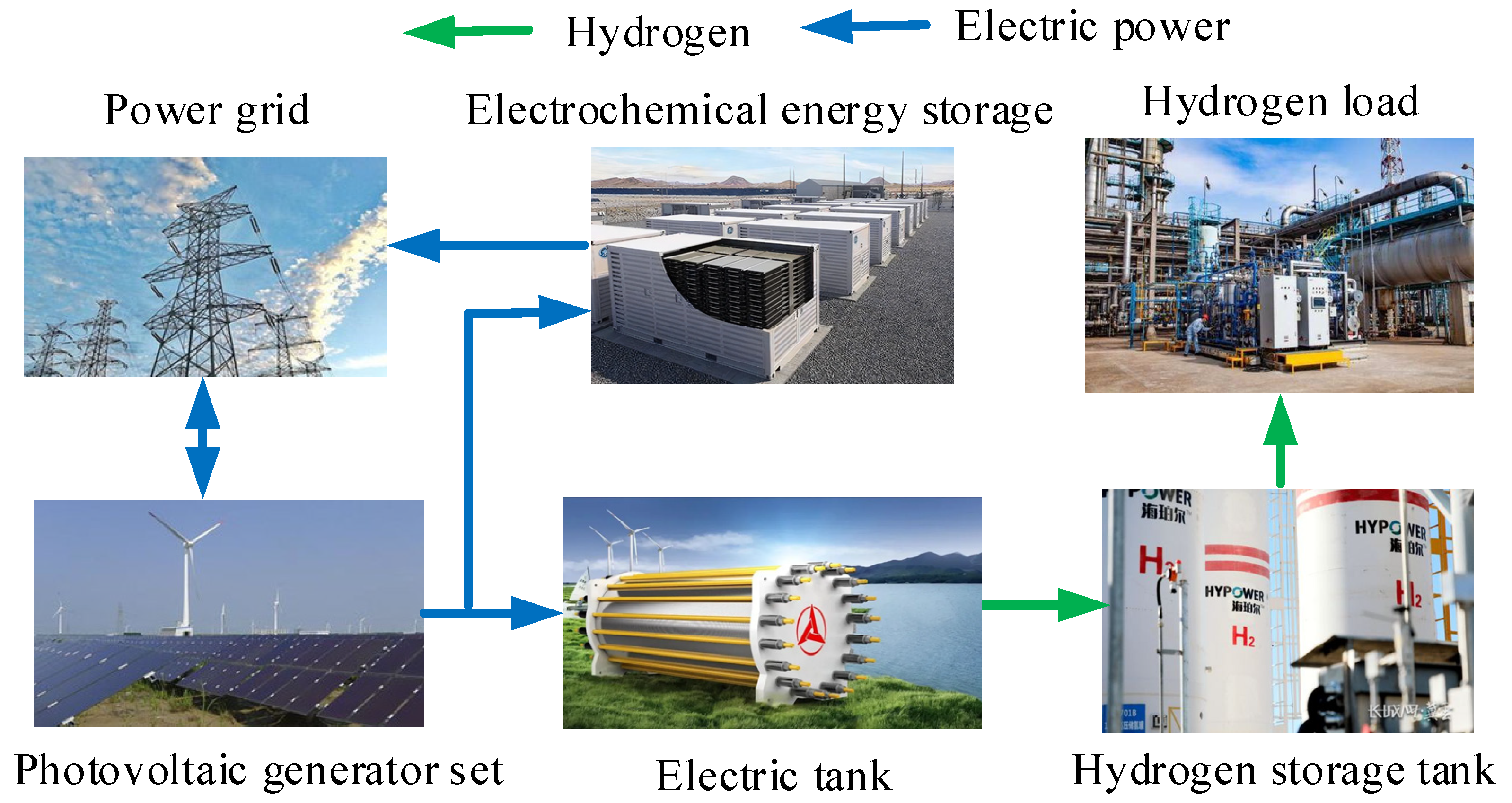
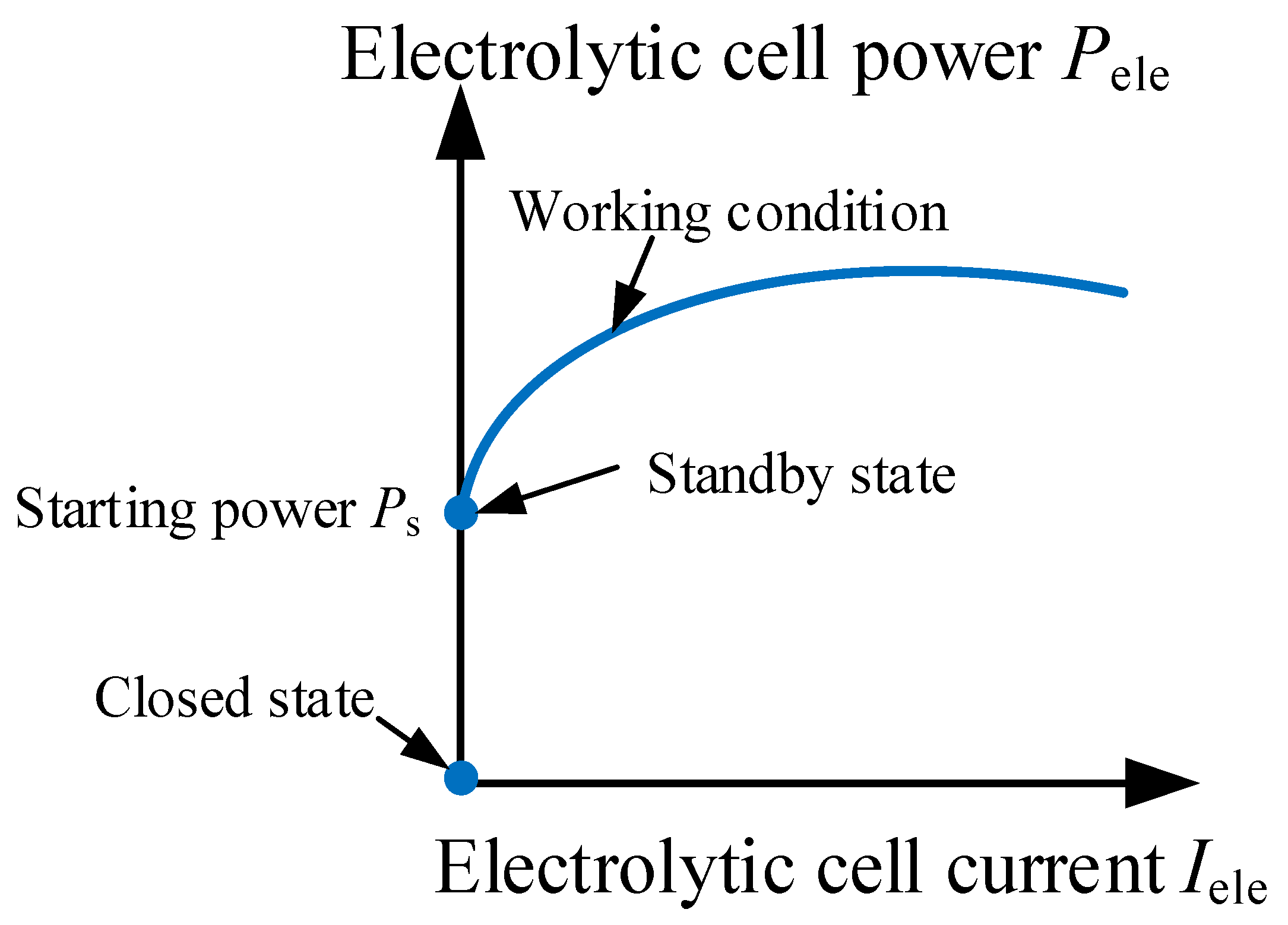


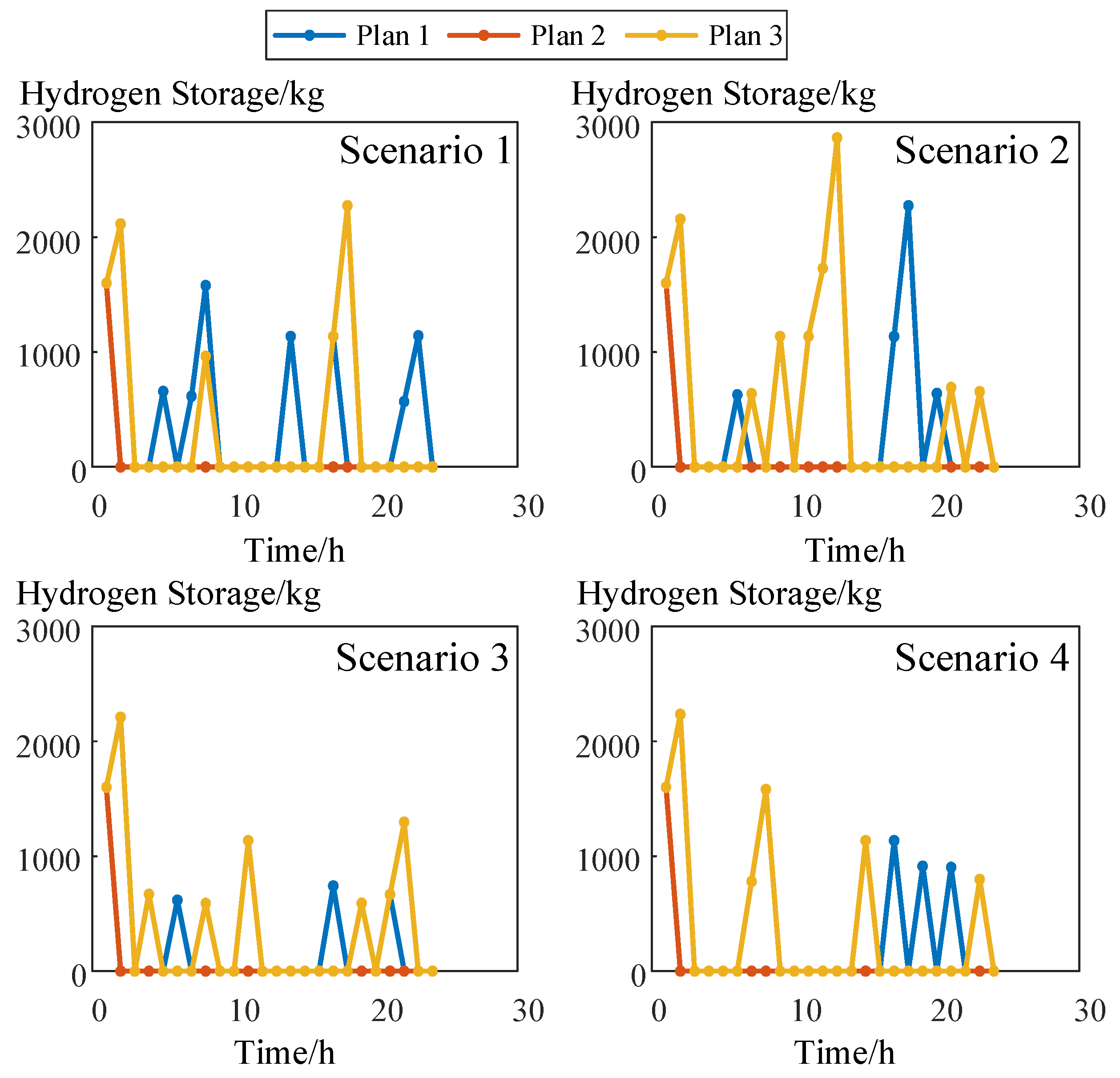
| Device | Rated Capacity |
|---|---|
| Hydrogen storage tank | 3000 kg |
| Wind turbine | 10 MW |
| Photovoltaic unit | 90 MW |
| Electrochemical energy storage | 10 MWh, 1 MW |
| Parameter | Value |
|---|---|
| r11 | 8.24 × 10−5 Ω m2 |
| r12 | −4.12 × 10−7 m2 °C−1 |
| r21 | 0.2393 V |
| r22 | −2.952 × 10−3 V °C−1 |
| r23 | 1.55 × 10−5 V °C−2 |
| r31 | 0.6767 A−1 m2 |
| r32 | −2.71 × 10−2 A−1 m2 °C−1 |
| r33 | 4.87 × 10−4 A−1 m2 °C−2 |
| r34 | −2.69 × 10−6 A−1 m2 °C−2 |
| A | 0.25 m2 |
| Uref | 1.229 V |
| Tm | 80 °C |
| Nel | 350 |
| Ps | 2 |
| , | 10, 300 |
| Scheme | Total Revenue | Electricity Sales Revenue | Hydrogen Sales Revenue | Abandoned Electricity Cost |
|---|---|---|---|---|
| 1 | 57.64 | −3.18 | 64.52 | 3.70 |
| 2 | 13.10 | 7.32 | 13.91 | 8.13 |
| 3 | 57.64 | −3.18 | 64.52 | 3.70 |
| Scheme | Power Generation/MW | Abandoned Power/MW | Abandonment Rate |
|---|---|---|---|
| 1 | 111.86 | 30.79 | 27.52% |
| 2 | 111.86 | 67.77 | 60.58% |
| 3 | 111.86 | 30.79 | 27.52% |
Disclaimer/Publisher’s Note: The statements, opinions and data contained in all publications are solely those of the individual author(s) and contributor(s) and not of MDPI and/or the editor(s). MDPI and/or the editor(s) disclaim responsibility for any injury to people or property resulting from any ideas, methods, instructions or products referred to in the content. |
© 2024 by the authors. Licensee MDPI, Basel, Switzerland. This article is an open access article distributed under the terms and conditions of the Creative Commons Attribution (CC BY) license (https://creativecommons.org/licenses/by/4.0/).
Share and Cite
Ma, B.; Zheng, J.; Xian, Z.; Wang, B.; Ma, H. Optimal Operation Strategy for Wind–Photovoltaic Power-Based Hydrogen Production Systems Considering Electrolyzer Start-Up Characteristics. Processes 2024, 12, 1756. https://doi.org/10.3390/pr12081756
Ma B, Zheng J, Xian Z, Wang B, Ma H. Optimal Operation Strategy for Wind–Photovoltaic Power-Based Hydrogen Production Systems Considering Electrolyzer Start-Up Characteristics. Processes. 2024; 12(8):1756. https://doi.org/10.3390/pr12081756
Chicago/Turabian StyleMa, Ben, Jianfeng Zheng, Zhongye Xian, Bo Wang, and Hengrui Ma. 2024. "Optimal Operation Strategy for Wind–Photovoltaic Power-Based Hydrogen Production Systems Considering Electrolyzer Start-Up Characteristics" Processes 12, no. 8: 1756. https://doi.org/10.3390/pr12081756




